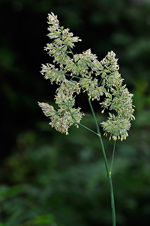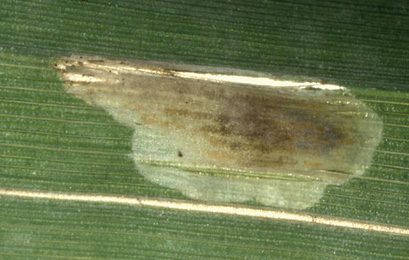|
||||||
|
DACTYLIS. Cock's-foots. [Poaceae] |
|
|
Two species of Dactylis are recorded in Britain. These include the native Cock's-foot (D. glomerata) and the introduced Slender Cock's-foot (D. polygama). Thirty-four British miners are recorded on Dactylis. A key to the European miners recorded on Dactylis is provided in Bladmineerders van Europa. Nearly 100 British miners or possible miners are recorded on grasses in Britain. It is recommended that adults of all miners on grasses be reared to be certain of their identity. |
|
Key for the identification of the known mines of British |
||
Note: Diptera larvae may live in a corridor mine, a corridor-blotch mine, or a blotch mine, but never in a case, a rolled or folded leaf, a tentiform mine or sandwiched between two more or less circular leaf sections in later instars. Pupation never in a cocoon. All mining Diptera larvae are leg-less maggots without a head capsule (see examples). They never have thoracic or abdominal legs. They do not have chewing mouthparts, although they do have a characteristic cephalo-pharyngeal skeleton (see examples), usually visible internally through the body wall. The larvae lie on their sides within the mine and use their pick-like mouthparts to feed on plant tissue. In some corridor miners frass may lie in two rows on alternate sides of the mine. In order to vacate the mine the fully grown larva cuts an exit slit, which is usually semi-circular (see Liriomyza huidobrensis video). The pupa is formed within the hardened last larval skin or puparium and as a result sheaths enclosing head appendages, wings and legs are not visible externally (see examples). See Key to non-Diptera. |
||
1# > ? Leaf-miner: Details of mine unknown. Pupation external (Spencer, 1972b: 52). Pupation external. |
||
|
||
Liriomyza phryne Hendel, 1931 [Diptera: Agromyzidae]. |
||
1a > Leaf-miner: Long, narrow, whitish mine. Pupation internal (Spencer, 1976: 453); anterior spiracles projecting through the epidermis. Whitish, upper-surface, rather narrow corridor with comparatively large frass grains that are laying further apart than their diameter. Pupation within the mine. The anterior spiracles of the orange-brown puparium penetrate the epidermis. |
||
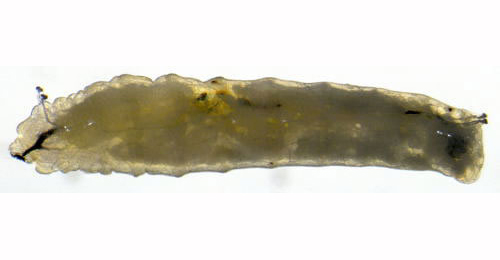 Chromatomyia nigra larva, lateral Image: © Willem Ellis (Bladmineerders van Europa) |
||
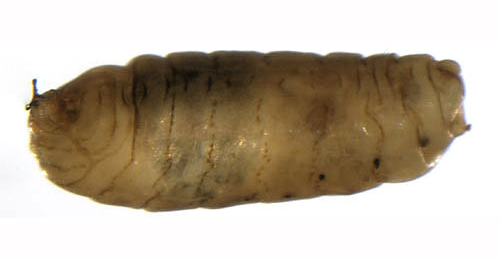 Chromatomyia nigra pupa, lateral Image: © Willem Ellis (Bladmineerders van Europa) |
||
|
||
Chromatomyia nigra (Meigen, 1830) [Diptera: Agromyzidae]. |
||
1b > Leaf-miner: Narrow whitish mine, with frass in distinct black lumps. Pupation internal (Spencer, 1976: 422). Whitish, upper-surface, descending corridor, about halfway up the blade. Frass in distinct black grains that are lying further apart than their diameter. Pupation in the mine. |
||
|
||
Chromatomyia fuscula (Zetterstedt, 1838) [Diptera: Agromyzidae]. |
||
1c > Leaf-miner: Pupation external or internal. If internal then anterior posterior spiracles not projecting through the epidermis. |
||
2a> Leaf-miner: Lower- or upper-surface corridor, possibly doubling one or two times, descends, sometimes as low as the leaf sheath. The gallery does not ocupy the entire width of the blade, runs along the midrib. Larva solitary. Frass as one big lump in the mine. Pupation internal. |
||
|
||
Cerodontha crassiseta (Strobl, 1900) [Diptera: Agromyzidae]. |
||
2b > Leaf-miner: Larva feeds mainly in the leaf sheaths. The short mines which may be formed in the leaf blade may be easily overlooked. Pupation internal (Spencer, 1976: 178). Mine begins as a narrow, usually upper-surface, occasionally lower-surface or interparenchymatous corridor in the blade, that descends towards the ligule, thence continues into the leaf sheath, generally on its inside. Usually only one mine per leaf. Puparium in a puparial chamber at the margin of the leaf sheath. Neither mine nor larva can be distinguished from that of C. fulvipes that, as far as is known, only feeds on Poa trivialis. |
||
|
||
Cerodontha denticornis (Panzer, 1806) [Diptera: Agromyzidae]. |
||
2c > Leaf-miner: Broad elongated mine; the form is dependent of the leaf form of the host plant. Frass green. Usually a number of larvae together in a mine. Pupation in the mine. |
||
|
||
Cerodontha incisa (Meigen, 1830) [Diptera: Agromyzidae]. |
||
2d > Leaf-miner: Normally several larvae feed together. Pupation in the mine. Puparium shining black (Spencer, 1976: 198). Broad elongated blotch. Frass greenish. Larvae generally communal. Pupation within the mine. The black puaria are individially anchored within the mine with a silken thread attached at their rear end. Distinguishable from C. incisa only by means of the larva. |
||
|
||
Cerodontha pygmaea (Meigen, 1830) [Diptera: Agromyzidae]. |
||
2e > Leaf-miner: A lower surface mine. Pupation normally in the ground (Spencer, 1976: 202). Broad, usually lower-surface corridor in the blade, generally first rising, then descending. Mostly one larva in a mine, but sometimes several mines on a leaf may merge. Frass in grains that gradually become both larger and more widely spaced. Pupation outside the mine. |
||
|
||
Cerodontha flavocingulata (Strobl, 1909) [Diptera: Agromyzidae]. |
||
2f > Leaf-miner: A linear mine running towards the apex of the leaf and this can widen and become almost blotch-like. Pupation internal (Spencer, 1976: 194, 195 (fig. 340). Upper surface corridor, mostly in the lower half of the blade, running upwards, and never occuping more than half the width of the leaf. Larva solitary. Frass in green smears. Pupation inside the mine. |
||
|
||
Cerodontha lateralis (Macquart, 1835) [Diptera: Agromyzidae]. |
||
2g > Leaf-miner: Broad lower surface mine which generally starts at the leaf apex.The mine is somewhat irregular in depth. Frass in irregular black-green, frequently melted grains, mostly along the edges of the mine. Larva solitary. Pupation generally internal. |
||
|
||
Cerodontha muscina (Meigen, 1830) [Diptera: Agromyzidae]. |
||
2h > Leaf-miner: Lower-surface corridor in the top half the leaf blade; the mine changes direction at least two times. One to three larvae in a mine. Frass in rather regular granules. |
||
|
||
Cerodontha atra (Meigen, 1830) [Diptera: Agromyzidae]. |
||
2i > Leaf-miner: Deep mine, broadened irregularly. Pupation external. Puparium reddish brown to black |
||
|
||
Agromyza cinerascens Macquart, 1835 [Diptera: Agromyzidae]. |
||
2j > Leaf-miner: Upper-surface corridor, generally in the upper half of the blade, running up to the leaf tip, usually occupying more then half the width of the leaf. Frass in green stripes at either side of the corridor. Never more than one larva in a mine. Puparium within the mine, metallic black, not anchered with a string of silk. |
||
|
||
Cerodontha superciliosa (Zetterstedt, 1860) [Diptera: Agromyzidae]. |
||
2k > Leaf-miner: Larvae feed singly, forming an upper surface linear-blotch mine. Pupation either internal or external, with the puparium loosely glued to the leaf (Spencer, 1976: 91). Oviposition near the leaf margin, at some distance from the leaf tip. From there develops an upper-surface corridor-blotch. At first the mine ascends as a narrow corridor towards the leaf tip, then the direction turns and the mine, steadily widening, descends in the direction of the leaf base. Frass irregular, in rather coarse grains. Larva solitary. Pupation mostly outside the mine; in that case the puparium often sticks to the leaf. |
||
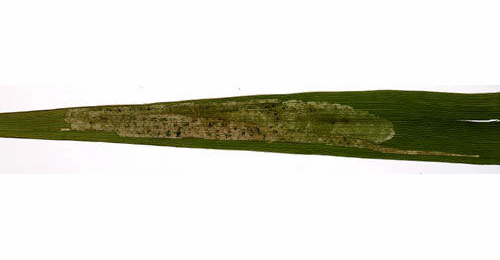 Mine of Agromyza albipennis on Phalaris arundinacea Image: © Willem Ellis (Bladmineerders van Europa) |
||
|
||
Agromyza albipennis Meigen, 1830 [Diptera: Agromyzidae]. |
||
2l > Leaf-miner: Larvae either singly or several in leaf, then forming large blotch-mine, feeding first up and then down the leaf. Pupation external (Spencer, 1976: 119). Shallow upper-surface corridor, without full-depth sections, starting high in the leaf. Initially the corridor runs up, but soon it changes direction, quickly widening. In Deschampsia generally one mine per leaf, occupying its entire width; in Glyceria there mostly are serveral mines that merge in the end. Pupation outside the mine; the puparium often sticks to the leaf. Puparium black or dark red |
||
|
||
Agromyza lucida Hendel, 1920 [Diptera: Agromyzidae]. |
||
2m > Leaf-miner: Larval leaf-mine starts as a narrow channel running towards apex of leaf but later develops into a broad blotch running downwards. Frass largely diffused, giving the mine a characteristic greenish appearance. Pupation external (Spencer, 1976: 126). Corridor, usually several in one leaf, running from close to the leaf base up to near the tip, then reversing direction and widening, resulting in one communal mine in which the larvae descend in a common front. Frass somewhat deliquescent, mine therefore strikingly green. Pupation outside the mine. Neither mine nor larva distinguishable from those of mobilis. Puparium reddish brown |
||
|
||
Agromyza nigrella (Rondani, 1875) [Diptera: Agromyzidae]. |
||
2n > Leaf-miner: The young larva first feeds towards the apex of the leaf, later turning and feeding downwards. Several larvae can occur together in a single leaf. Pupation external (Spencer, 1976: 130). Upper-surface, greenish, gradually widening corridor, at first running towards the leaf tip, then reverses. Through fusion of several mines the final mine is often communal. Frass in backish green grains, often washed out. Pupation outside the mine. Puparium reddish brown |
||
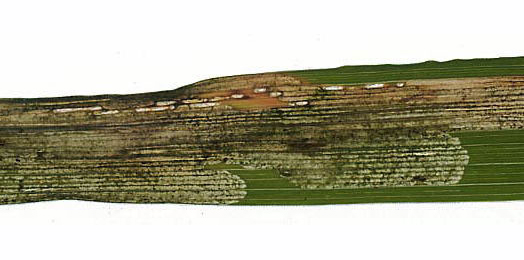 Mine of Agromyza nigrociliata on Arrhenatherum elatius Image: © Willem Ellis (Bladmineerders van Europa) |
||
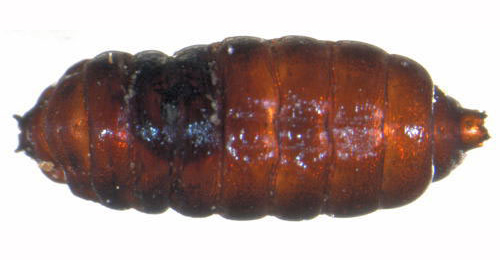 Agromyza nigrociliata puparium Image: © Willem Ellis (Bladmineerders van Europa) |
||
|
||
Agromyza nigrociliata Hendel, 1931 [Diptera: Agromyzidae]. |
||
| 2o > Leaf-miner: Mine greenish with only single larva, initially running towards apex of leaf before turning back down and developing into a broad blotch. Puparium reddish brown | ||
|
||
Agromyza rondensis Strobl, 1900 [Diptera: Agromyzidae]. |
||
2p > Leaf-miner: A narrow whitish linear mine, running down the leaf from the apex, with frass in two rows of separate grains. Pupation external (Spencer, 1976: 246). Narrow corridor from start to end, whitish, uppper- or lower-surface, genarally running downwards. Mine often along the leaf margin. Frass in distict grains of regular size, alternating along the sides of the corridor. Pupation outside the mine. |
||
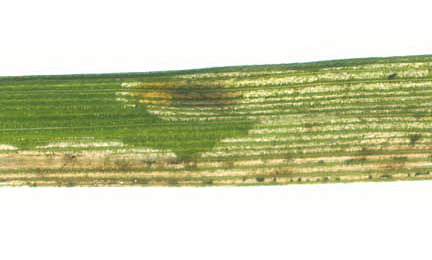 Mine of Liriomyza flaveola on Festuca gigantea Image: © Willis Ellis (Bladmineerders van Europa) |
||
|
||
Liriomyza flaveola (Fallén, 1823) [Diptera: Agromyzidae]. |
||
2q > Leaf-miner: A short narrow mine, generally near apex of leaf. |
||
|
||
Pseudonapomyza atra (Meigen, 1830) [Diptera: Agromyzidae]. |
||
2r > Leaf-miner: Irregular mine, locally shallow, elsewhere much deeper, giving it a mottled appearance. In broadleaved plants the mine often begins as a blotch with stellate extensions, but sometimes as a very fine, shallow corridor. In grasses the mine often begins in the leaf sheath. The frass is very fine-grained, initially scattered, later in aggregates. |
||
|
||
|
||
Hydrellia griseola (Fallén, 1813) [Diptera: Ephydridae]. |
|
Key for the identification of the known mines of British |
Note: The larvae of mining Coleoptera, Hymenoptera and Lepidoptera may live in a corridor mine, a corridor-blotch mine, a blotch mine, a case, a rolled or folded leaf, a tentiform mine or sandwiched between two more or less circular leaf sections in later instars. Larva may pupate in a silk cocoon. The larva may have six legs (although they may be reduced or absent), a head capsule and chewing mouthparts with opposable mandibles (see video of a gracillarid larva feeding). Larvae of Hymenoptera and Lepidoptera usually also have abdominal legs (see examples). Frass, if present, never in two rows. Unless feeding externally from within a case the larva usually vacates the mine by chewing an exit hole. Pupa with visible head appendages, wings and legs which lie in sheaths (see examples). |
1a > Leaf/Stem miner: The larvae mine the stems of various coarse grasses (UKMoths; Plant
in Pitkin & Plant, 2005). The larva mines just a few days in the leaf, then continues as a stem borer on the lower part of the stem. They regularly move to a new stem. The central leaves of the infested plants wither and die. |
|
Ochsenheimeria taurella (Denis & Schiffermüller, 1775) [Lepidoptera: Ypsolophidae]. |
1b > Leaf-miner and case-bearer: The larva lives outside the mine, protected by a case, and feeds on the underlying plant tissues via a hole cut in the epidermis. From that point it eats away as much leaf tissue as it can reach without fully entering the mine. Mine does not contain frass (Coleophora species) |
1c > Leaf-miner, but not a case-bearer: The larva lives mainly inside the mine. Mine usually contains frass. In later instars the larva may live sandwiched between two more or less circular sections cut from the leaf. |
2a > Leaf-miner and case-bearer: The young larva eats the receptacle out of a floret of Acinos arvensis, and uses the calyce as its first case. Even before the onset of winter it switches to grasses. The larva then lives in an ochraceous, bivalved, tubular leaf case of c. 9 mm, with a mouth angle of c. 25°. The case is illustrated in British Leafminers. |
|
Coleophora tricolor Walsingham, 1899 [Lepidoptera: Coleophoridae]. |
2b > Seed-feeder, leaf-miner and case-bearer: Initially it feeds on the seeds of thyme and then uses the seedhead as a case. It overwinters in this case and starts feeding again in March on grass spp. It then makes a case from the mined blade of grass. The larva initially feeds on the seeds of thyme, feeding within a floret and using this as its case. After overwintering, it changes foodplants to grass, and eventually forms an elongated case from two grass blade portions sewn together. The larva begins its life by eating out the ripe fruit of a thyme floret. The emptied and dried calyx functions as its first case, in which it hibernates. After hibernation the larva switches to grasses, initially in its original thyme case. Later a new case is made out of a mined grass leaf. This final case is about 11 mm long, two-valved, straw-coloured, has a mouth angle of 25°, and bears a striking resemblance to a grass spikelet. |
|
Coleophora lixella Zeller, 1849 [Lepidoptera: Coleophoridae] |
3a Leaf-miner: In the first instar the larva mines the leaves, forming short, irregular, blotch-like mines, but in later instars it lives externally, feeding in spun leaves and often twisting those of tender shoots. Larval head light-brown or yellowish brown, edged with black postero-laterally, ocellar area blackish; prothoracic plate black edged with whitish anteriorly; abdomen dull dark green; pinacula distinct, black, sometimes brownish but with black bases to setae; anal plate large, black (Bradley et al., 1973). Small, full depth mine without a definite shape; little frass. Some silk is deposited in the mine. The larva soon leaves the mine and continues feeding among spun leaves. |
|
Cnephasia incertana (Treitschke, 1835) [Lepidoptera: Tortricidae]. |
3b > Leaf-miner: The larva mines from the grass tip downwards and the mine occupies half or the whole of the leaf blade width. A whitish blotch is formed with characteristic narrow streaks of frass. Full depth blotch, slightly inflated, descending from the leaf tip, occupying half or the entire width of the blade. The larva may move and make a new mine elsewhere. In the latter case the mines are fairly short; otherwise an entire blade may be mined out. Frass in a some narrow greyish brown streaks. Pupation outside the mine. |
|
Elachista albifrontella (Hübner, 1817) [Lepidoptera: Elachistidae]. |
3c > Leaf-miner: Corridor widening while descending from the tip of the leaf. The mine is unusual because the sides are very irregularly scalloped out. Moreover, the mine is not evenly transparent, but rather yellowish green and motly, because the larva leaves patches of parenchyma uneaten, and does not feed full depth. Frass in a few irregular, interrupted length lines. Often 2-3 larvae in a mine. The larvae hibernate in the centre of the mine; after winter they leave their mine and pupate. |
|
Elachista apicipunctella Stainton, 1849 [Lepidoptera: Elachistidae]. |
3d > Leaf-miner: In autumn the larva makes a narrow corridor a few cm in length, in which it hibernates. In March it moves to a new leaf. Here a transparent, full depth mine is made that descends from the leaf tip, and occupies the entire width of the blade. Most frass is concentrated in the oldest, highest, part of the mine. The larva may leave its mine and restart elsewhere. Pupation outside the mine |
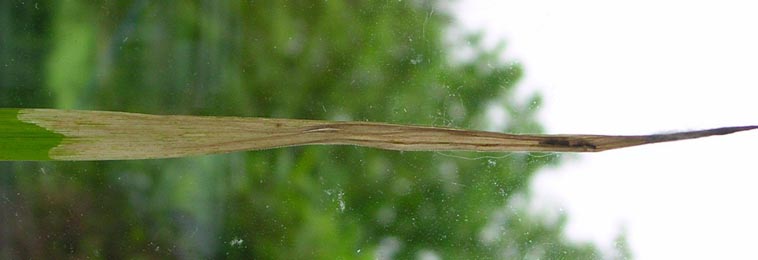 Mine of Elachista argentella on Dactylis glomerata Image: © Ben Smart (British leafminers) |
|
Elachista argentella (Clerck, 1759) [Lepidoptera: Elachistidae]. |
3e > Leaf-miner: Like related species, the larva mines blades of grass, in this case usually Cock's-foot, forming a thin whitish mine. The larva begins in autumn the making of a long, narrow, corridor with a fine central line of grey frass. The corridor is straight or lightly wavy, and descends into the leaf sheath, or even into the stem or rootstock. The larva regularly leaves the mine to begin making a new one. Pupation external. |
|
Elachista atricomella Stainton, 1849 [Lepidoptera: Elachistidae]. |
3f > Leaf-miner: The larvae mine the blades of various grasses, including meadow-grass and cock's-foot. Long, flat, whitish, relatively broad corridor descending from the leaf tip. Frass irregularly scattered. The larva may make several mines during its lifetime. Pupation outside the mine. |
|
Elachista freyerella (Hübner, 1825) [Lepidoptera: Elachistidae]. |
3g > Leaf-miner: The larva mines downwards and forms an irregular mine with a silken tube in the centre, which is mixed with frass. Mine transparent (therefore conspicuous), generally descending from the leaf tip. Over the entire length of the mine stretches a central silken tube, in which the larva can retreat and can move quickly up or down. The tube also contains the frass. The larva feeds laterally from the tube, which makes the sides of the mine very irregular. |
|
Elachista gangabella Zeller, 1850 [Lepidoptera: Elachistidae]. |
3h > Leaf-miner: Long, narrow, white corridor, descending from close to the leaf tip to the leaf base or even stem. Frass in an inconspicuous grey line. From the stem the larva may enter a new leaf (Steuer, 1987a; Bland, 1996a). |
|
Elachista luticomella Zeller, 1839 [Lepidoptera: Elachistidae]. |
3i > Leaf-miner: Larva makes a large whitish blotch and mines the leaf downwards. The frass tends to be deposited in the upper part of the mine. Oviposition usually not far from the leaf tip. From there descends an irregular blotch mine. Hering (1957a) describes the mine as flat and quite shallow, giving it a greenish, rather than whitish appearance. Frass initially in the oldest, upper part of the mine, later in strings. The larva can leave its mine and restart elsewhere. Normally only one larva per mine, but sometimes two or even three mines in a leaf. Pupation outside the mine. |
|
Elachista maculicerusella (Bruand, 1859) [Lepidoptera: Elachistidae]. |
3j > Leaf-miner: Initially a narrow brownish mine with blackish frass at its base, then moves to another leaf, forming a broader mine. Both mines can pucker the blade. |
|
Elachista obliquella Stainton, 1858 [Lepidoptera: Elachistidae]. |
3k > Leaf-miner: Narrow, flat, corridor descending from the leaf tip. Frass in an almost continuous line. The larva usually makes several mines. Mines pale yellow green at first, turning purple later. Pupation external. |
|
Elachista subnigrella Douglas, 1853 [Lepidoptera: Elachistidae]. |
3l > Leaf-miner: In autumn the larva makes a long, somewhat blistered, slightly transparent corridor. In spring it mines the basal leaves that lie on the ground. These mines are swollen, clouded green, opaque, and the mined tips of the leaves are puckered and shrunken, filled with frass. |
|
Elachista unifasciella (Haworth, 1828) [Lepidoptera: Elachistidae]. |
| Last updated 03-Jul-2019 Brian Pitkin | ||

